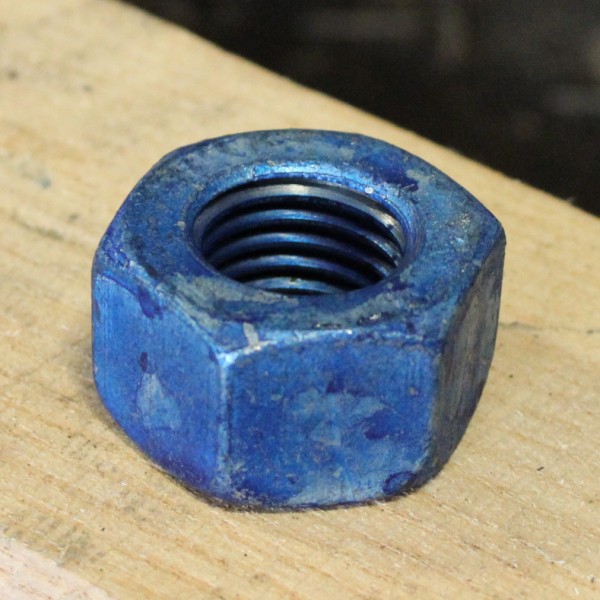 It is often asked why some high strength hex nuts that are supplied with high strength bolts appear to be blue or some other color. This is normally the case with galvanized, high strength, heavy hex nuts and the reason for this is because of the wax lubricant applied to the nuts. According to the ASTM A563 specification, “Hot-dip and mechanically deposited zinc-coated Grade DH nuts shall be provided with an additional lubricant which shall be clean to the touch”. The dye color is so that the presence of the lubricant is obvious and recognizable. Supplementary Requirement S2 under ASTM A563 specifies that the lubricant shall have a contrasting color to make its presence obvious, however it is not required unless specified. Since the A563 specification only requires an additional lubricant for galvanized DH nuts, Supplementary Requirement S1 can be specified, which requires that the nuts shall be provided with an additional lubricant regardless of the finish.
It is often asked why some high strength hex nuts that are supplied with high strength bolts appear to be blue or some other color. This is normally the case with galvanized, high strength, heavy hex nuts and the reason for this is because of the wax lubricant applied to the nuts. According to the ASTM A563 specification, “Hot-dip and mechanically deposited zinc-coated Grade DH nuts shall be provided with an additional lubricant which shall be clean to the touch”. The dye color is so that the presence of the lubricant is obvious and recognizable. Supplementary Requirement S2 under ASTM A563 specifies that the lubricant shall have a contrasting color to make its presence obvious, however it is not required unless specified. Since the A563 specification only requires an additional lubricant for galvanized DH nuts, Supplementary Requirement S1 can be specified, which requires that the nuts shall be provided with an additional lubricant regardless of the finish.
When lubricated A563DH nuts are supplied, they will typically possess a contrasting color, most often blue, regardless of whether or not the supplementary requirement, S2, has been specified. This makes the lubrication easy to recognize and alleviates any potential confusion. Another thing to keep in mind is that ASTM A194 2H nuts may also come with a dyed lubricated coating. The reason for this is because the ASTM A563 specification allows for A194 2H nuts as an acceptable substitute for A563DH.

Hi, after doing this at multiple shops, here’s what I’ve found:
1. CRC Heavy Duty Pro-Strength Degreaser – Best results. It sprays on, foams up, and lubricant comes off easily with manual wire brush. This will also remove the lubricant in the crevices. I bet spraying the foam plus pressure washing would also work.
2. MEK and power wire brush – Second best results. Takes some time to remove the lubricant in the crevices and may need to supplement with manual wire brush or “flossing” with a rag.
3. Pressure washing with hot water – Mixed results based on personnel. May take a while, may need to stand closer for a longer time. Beware that some galvanizing may be ripped off depending on your pressure, or surrounding paint.
4. Savogran TSP (Trisodium Phosphate) – Worst results. Recommended by Federal Highway Administration. We sprayed this and let it soak for a while. It hardly came off with a wire brush or pressure washer. Other people must have had success; maybe we didn’t use it correctly. Maybe try with a power wire brush?
@Autumn- thank you for your suggestions.
Is there a standard for how long the color is to remain visible, especially after installation in the field? We have had some episodes where the bolts and nuts have “sat” in the field for a few weeks before installation and the color was gone. What should we be concerned about?
Thank you
@Tony- There are no standards for how long the wax must last once it is exposed to weather. The wax is typically water soluble, so it will deteriorate over time. The concern would be that if the wax itself has washed away, the nuts will not perform as well as they should – you will likely get some galling. If instead it is simply that the color that has faded, but the wax is still present, then my concern would be lessened.
What about situations were the bolt must be turned from the head? The lack of lubrication between the head of the bolt and the washer greatly increases the torque required.
@Joe- A great many factors can alter the torque needed to achieve tension, that is why torque should not be relied upon without verification. This is certainly one of those factors.
WILL THE BLUE WAX AFFECT CONCRETE ADHESION IF USED IN ANCHOR BOLTS? FOR INSTANCE A F1554 ANCHOR ROD WITH EITHER A563DH OR A194 2H NUTS WITH THE WAX COATING?
@Bill- No, the blue wax should not make a difference. If it is on the top nut, then it will of course be out of the concrete, and if it is on the encased end, it only serves to hold the bolt in place, so you shouldn’t have any issues with waxed nuts.
How can I obtain the wax with which to lubricate galvanized nuts when in a pinch? We are installing new steel columns on existing anchor bolts…
@Chris – I don’t believe there is a standard or recommended wax – any stick wax obtained from your industrial supplier should be sufficient.